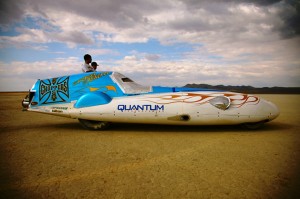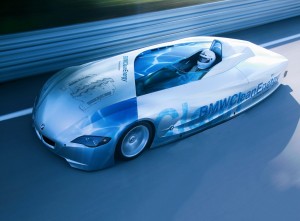A hydrogen-powered “streamliner” claims to have beaten the BMW H2R to move into the land speed record books. The H2R had posted a 186 mph top speed record during an FIA sanctioned run in Germany, which requires the speed by maintained for one mile, among other technical requirements.
So until the timing is completed, sorted, certified and accepted by sanctioning bodies, such as the FIA, the BMW apparently still holds nine records for hydrogen-fueled cars running with an internal combustion engine. Wanna bet we haven’t heard the last on this from BMW?
The Quantum car, driven by Jesse James, was clocked at 199.712 mph at El Mirage Dry Lake Bed in the Mojave Desert last week. The publicity stunt will be shown on “Jesse James Is a Dead Man” on Sunday, August 9 at 10:00 PM on Spike TV.
The run was supported by 24 Quantum hydrogen injectors that fuelled an 8-cylinder engine, provenance unspecified, which was rated at 704 horsepower. Quantum claims its patented fuel injector has been “designed, tested and validated” specifically for precision fuel metering and durable service with cleaner burning, dry gaseous fuels such as hydrogen and natural gas.
 Quantum’s gaseous fuel injectors are used in Ford’s hydrogen internal combustion engine vehicles and Toyota Prius and Escape hydrogen hybrid electric vehicles, which have been developed by Quantum. All are technical curiosities right now — albeit of the advanced research sort — rather than serious alternatives to existing technology.
Quantum’s gaseous fuel injectors are used in Ford’s hydrogen internal combustion engine vehicles and Toyota Prius and Escape hydrogen hybrid electric vehicles, which have been developed by Quantum. All are technical curiosities right now — albeit of the advanced research sort — rather than serious alternatives to existing technology.
The Quantum car was fitted with three, carbon-fiber composite, 5,000 psi rated, hydrogen storage cylinders made by Quantum. Among the many, many challenges facing hydrogen as a fuel is where it comes from and how to store it.
Hydrogen as a gas has reasonable energy density by weight, but extremely bad energy density by volume when compared with gasoline. That is why it requires a much larger fuel tank — or tanks — to store it when compared to the gasoline tank in your car. Then you get into age old trade-offs that seriously diminish its practicality as a fuel. A larger tank means a heavier tank to store anywhere the near the energy need for practical driving range, unless you want to run a couple of miles at a time between refueling like a dry-lake racer. Increasing the gas pressure improves the energy density by volume somewhat, but now you are into complex, expensive systems.
To address this Quantum has developed 3,600 psi natural gas on-board storage cylinders, and 5,000 and 10,000 psi hydrogen storage cylinders, along with the related valves and pressure management systems.
While completely impractical now, there are reasons to keep research into hydrogen fuels ongoing. A fuel cell vehicle — in theory — is radically different approach to transportation than that taken by internal combustion engines. As in battery-electric vehicles, a fuel cell vehicle (FCV) is driven by an electric motor or motors. However, battery vehicles use electricity from an external source, while fuel cell vehicles can create their own electricity. Using pure hydrogen to do this emits no pollutants, while using hydrogen-rich fuels and a “reformer” to convert them to hydrogen produces some small amount of air pollutants.
As we said, a fuel cell vehicle can be fueled with pure hydrogen gas, which needs to be stored on-board in expensive high-pressure tanks. One potential work around to the problem is to use hydrogen-rich fuels — methanol, natural gas, or even gasoline — but these fuels must first be converted into hydrogen gas by the reformer. It’s like buying your own oil refinery with the car, and about as expensive.



Department of Disclosure:
After I posted this story I received a polite, private note from Louise Ann Noeth. We go back 30 years to when I was the editor on Motor Magazine at Hearst in New York City. I’m not sure Louise was old enough to have a driver’s license then, but she was expert about dry lake racing and the Southern California Timing Association. In the passing years, her knowledge has only increased, and her passion for the sport is undiminished.
Following is her note.
Ken: I got wind of a new posting on your website that reeks of fraud. As you may know I am immersed in the land speed culture these days, my book on Bonneville is now in its seventh printing, and I am working with an educational firm to develop a national science and math-based curriculum using land speed racing.
I am very upset with Mr. James trying to hijack the sport with his lie. Below are a few facts you may not be aware of and may want to share with your readers:
Cable TV personality Jesse James claims he set the world record for hydrogen-powered vehicles on June 16th on the southern California El Mirage dry lake.
The claim is without merit since the activities were conducted without benefit of any motorsports sanctioning authority. The vehicle was neither inspected, nor certified and all the timing personnel were on the James TV payroll.
World speed records require two runs over a one-mile course within one hour. James was 5,148 feet short — being timed one-way for a total of 132 feet; he made only three or four passes over an eight to ten-hour period. Any world record holder will tell you it’s quite a technical feat to hold speed for a full mile.
The baseless speed stunt was reportedly for “the season-ending episode of James’s TV show, Jesse James is a Dead Man.” The episode is set to air in early August.
James claims to have bested the FIA ratified BMW HR2 record of 185 mph. The BMW HR2 race car set 9 international and FIA-ratified land-speed records for hydrogen cars at the Miramas Proving Grounds in France. The BMW HR2 is one of the few hydrogen cars developed with an internal combustion engine (ICE) technology instead of fuel cell technology.
Mr. James efforts count for absolutely nothing on the world motorsports’ stage and amounts to little more than a self-promoting “TV racer” PR stunt since he chose to ignore the sport’s sanctioning rules that have applied to all records certified for the past 80 years.
Further, Quantum Fuel Systems Technologies Worldwide, Inc., a supplier of parts to the car has posted the release on PR Newswire with a solicitation for stock investment. This has generated numerous news stories around the globe propping up the lie that is enhancing the image of a company to sell stock.
The sad part is that the car itself is something to take note of, but its credibility as an alternative fuel vehicle is diminished by the lie of a world record.
When contacted to explain the fraudulent claim, James responded with a short crude retort that reminded this writer that vulgarity is indeed the refuge of a destitute mind.
Speedy Regards,
“LandSpeed” Louise Ann Noeth
Member: Society of Professional Journalists, American Auto Racing Writers & Broadcasters, Motor Press Guild, Society of Automotive Historians, Western Automotive Journalists, Society of Land Speed Racing Historians http://www.landspeedproductions.biz
With all due respect from an innocent bystander, Ms. Noeth strikes me as having an itchy trigger finger.
I can understand this reaction but also know the value of looking before you leap.
Now, the the obligatory cliches are out of the way, I have no relationship to any of the principles of this discussion but Ms. Noeth’s use of “reeks of fraud,” in the very first line of her comment struck one of my “offended” nerves. I would have expected a case-building to come before a direct accusation.
My own initial assumption would have been quite different. The producers are usually the people responsible for setting this stuff up. The “talent” may have some control or none. This has been the case in shows where I have some familiarity with inner workings.
Feelings seem to be understandably strong here. When I’ve been at that point a more diplomatic approach (which Mr. Zino navigated quite well above.) would have served me well. Unfortunately, that wasn’t my style at the time. That’s how I learned what I’m saying now.
WD Smith and other interested parties . . .
I guess I feel strongly about this and fraud is fraud, whether I wrote the release in a way you approve of or not. I took a public stand when Mr. James crudely expressed his disdain for ANY criticism of his TV show racing.
Earning a national land speed record is hard enough, but a world record can take years and sometimes also takes your life.
I’ve been to enough funerals and visited many racers in hospital beds over the years so that when someone claims fraternity with a land speed racer, they should earn it with integrity.
My “style” is forthright and candid, especially when someone attacks the very heart of the sport I have come to respect. Land speed racing is populated by ordinary people doing extraordinary feats of innovative engineering and science. Shame to anyone who would cheapen their efforts.